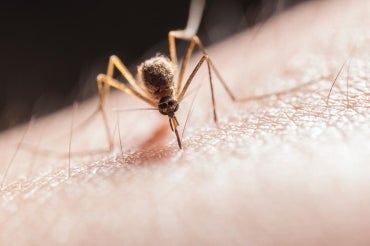U of T biologist explains why there were so many mosquitoes this year

(photo by Jimmy Chan/Pexels)
Published: September 21, 2023
If you think there were more mosquitoes this year than usual, you’re not wrong.
Spring and summer in 2023 saw record temperatures across the globe, including in southern Ontario. Combined with a wetter-than-average season, that meant mosquitoes had more habitats in which they could reproduce and grow.
“It’s been extremely wet,” says Rosalind Murray, an assistant professor of biology at the University of Toronto Mississauga who studies insects. “That’s one of the main reasons we saw so many mosquitoes early on in the season.”
Mosquitoes, which hibernate over the winter, emerge to lay their eggs – usually in stagnant pools of water – as the temperature approaches 15 C.
And this year’s conditions were ideal: A warm spell in April melted lingering snow from the winter and was followed by heavy precipitation in May and June. That, in turn, created more habitat options for the insects to breed – including puddles in urban areas.

“As soon as it gets warm, they fly out of their hibernation areas and lay eggs wherever they can ... like parking lots or flooded lawns,” Murray says. “Mosquitoes are hardy – they can often survive in these puddles of water.”
If temperatures don’t cool off at night between warm spells – as was the case this spring – then mosquitoes have ideal conditions to proliferate. Warmer temperatures also increase the number of bacteria found in puddles, which mosquitoes eat.
And the warmer the temperatures, the faster mosquitos hatch. At 10 C, mosquitoes can grow from egg to adult in around 40 days, while in temperatures higher than 25 C, it takes just four days for mosquitoes to grow to adulthood. Depending on the species, mosquitoes live for a few days or a few weeks.
“There’s huge turnover of these animals, especially if we have wet and warm conditions where there’s a lot of habitats for them,” Murray says. “Their metabolism speeds up because it’s so warm.”
Climate change is exacerbating the wet and warm conditions favoured by mosquitos, bringing higher temperatures and more energetic weather systems. A growing concern is that southern species of mosquitoes are migrating to northern latitudes, serving as vectors for dengue fever, West Nile virus or the Zika virus.
“We are seeing more and more of these tropical species moving north,” Murray says.
One of Murray’s graduate students, Sherry Du, studies sexual dimorphism in mosquitoes. Du’s research reveals that mosquitoes are showing an affinity for puddles containing high concentrations of road salts.
“Mosquitoes have been found to love those environments,” Du says. “Urban or city mosquitoes are tough and hardy – they can tolerate polluted water conditions.”
Salty environments, meanwhile, place stress on dragonflies, which prey on mosquitoes. That means more mosquitoes survive because fewer are being eaten.
While warming temperatures could result in more mosquitoes than normal, it’s not a given. A dry season could negatively affect mosquito populations by limiting their habitat, Murray says.
As expected, mosquito populations began to dwindle in September and into the fall as they return to hibernation.
“But if we have a huge heat wave, then they’re going to come out,” Murray says.


